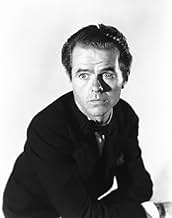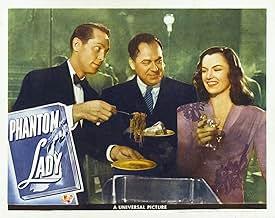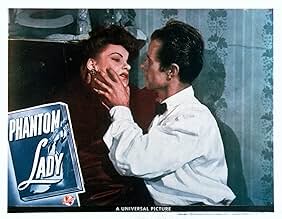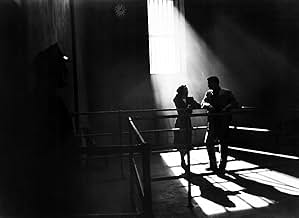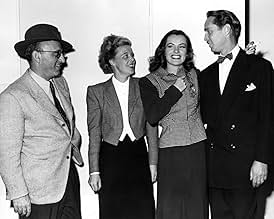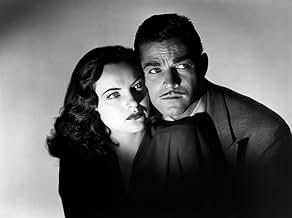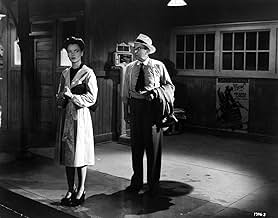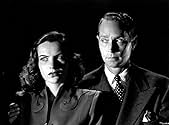AVALIAÇÃO DA IMDb
7,2/10
6,2 mil
SUA AVALIAÇÃO
Adicionar um enredo no seu idiomaA devoted secretary risks her life to try to find the elusive woman who may prove her boss didn't murder his selfish wife.A devoted secretary risks her life to try to find the elusive woman who may prove her boss didn't murder his selfish wife.A devoted secretary risks her life to try to find the elusive woman who may prove her boss didn't murder his selfish wife.
- Direção
- Roteiristas
- Artistas
Aurora Miranda
- Estela Monteiro
- (as Aurora)
Milburn Stone
- District Attorney
- (narração)
Harry Adams
- Courtroom Spectator
- (não creditado)
Robert Bain
- Guitarist
- (não creditado)
Joan Bayley
- Dancer
- (não creditado)
Brandon Beach
- Theatre Party Guest
- (não creditado)
Brooks Benedict
- Theatre Party Guest
- (não creditado)
- Direção
- Roteiristas
- Elenco e equipe completos
- Produção, bilheteria e muito mais no IMDbPro
Avaliações em destaque
Seldom have my expectations been as often derailed as in The Phantom Lady. The plot--while a bit farfetched--is never boring or predictable. Although it's a smaller film than say, The Maltese Falcon or The Big Sleep, it is immensely satisfying.
Ella Raines is the real stand-out here. Not only is she great to look at (think half-way between Veronica Lake and Lauren Bacall) she also acts circles 'round the two leading men. Luminous, expressive yet subtle, she is perhaps a better actress than those two icons, if slightly less perfect-looking than Lake and a bit less magnetic than Bacall.
Thomas Gomez turns in a surprisingly complex and interesting performance, but don't expect too much from Franchot Tone. Although his acting abilities need no defense, he didn't do much with this role.
Sure, there are plot holes, a couple of contrived turns, and at least two ridiculous performances (Elisha Cook and Aurora Miranda) but all B Noir has its faults, and this one wins by dint of its unpredictability and pacing, and some great cinematography. Oh--and miss Raines.
Ella Raines is the real stand-out here. Not only is she great to look at (think half-way between Veronica Lake and Lauren Bacall) she also acts circles 'round the two leading men. Luminous, expressive yet subtle, she is perhaps a better actress than those two icons, if slightly less perfect-looking than Lake and a bit less magnetic than Bacall.
Thomas Gomez turns in a surprisingly complex and interesting performance, but don't expect too much from Franchot Tone. Although his acting abilities need no defense, he didn't do much with this role.
Sure, there are plot holes, a couple of contrived turns, and at least two ridiculous performances (Elisha Cook and Aurora Miranda) but all B Noir has its faults, and this one wins by dint of its unpredictability and pacing, and some great cinematography. Oh--and miss Raines.
'Phantom Lady' (retitled in my country as 'Witness wanted') is a little gem for anyone who appreciates 1940s film noir. It need not feature any of the big stars (Bogart, Cagney, Laughton, Ladd etc.), because its strengths are its excellent b/w photography and an interesting story that doesn't rely on predictable clichés of the genre.
Scott Henderson (Alan Curtis) is arrested for the murder of his wife. He is completely innocent, since he spent the evening at a theater with an unknown woman he invited after he met her at a bar (yes, his marriage has seen better days). But when asked for an alibi, not only that 'phantom lady' has disappeared, also several witnesses deny to have seen him with her. Thus, he's thrown into jail, and only his secretary (Ella Raines) and inspector Burgess (Thomas Gomez) don't give up the investigation. When Marlow (Franchot Tone), an old friend of Henderson, offers his assistance, the investigation is taking up speed, but meanwhile another witness was murdered. How can they defend Henderson without witnesses?
What I liked especially about 'Phantom Lady' is that there is no actual hero. Henderson is giving up, sits in his prison cell all day and doesn't show any hope. It's almost like he wants to be imprisoned for something he didn't do. So it's really the secretary who becomes the central character, driving the search for the real murderer. Quite unusual for the times and well worth watching.
Scott Henderson (Alan Curtis) is arrested for the murder of his wife. He is completely innocent, since he spent the evening at a theater with an unknown woman he invited after he met her at a bar (yes, his marriage has seen better days). But when asked for an alibi, not only that 'phantom lady' has disappeared, also several witnesses deny to have seen him with her. Thus, he's thrown into jail, and only his secretary (Ella Raines) and inspector Burgess (Thomas Gomez) don't give up the investigation. When Marlow (Franchot Tone), an old friend of Henderson, offers his assistance, the investigation is taking up speed, but meanwhile another witness was murdered. How can they defend Henderson without witnesses?
What I liked especially about 'Phantom Lady' is that there is no actual hero. Henderson is giving up, sits in his prison cell all day and doesn't show any hope. It's almost like he wants to be imprisoned for something he didn't do. So it's really the secretary who becomes the central character, driving the search for the real murderer. Quite unusual for the times and well worth watching.
I'll admit that I like a certain degree of plausibility in films. Thus, it was hard for me to totally embrace this movie after watching the scene in which the husband (Alan Curtis) comes home to his darkened apartment and calls out for his wife, wondering where she is,unaware that detectives were there waiting for him. It was obvious that Curtis expected the wife to be home, not to mention alive, yet the detectives never took this into consideration. If you strangled your spouse, would you return home later and call out for her? Besides, who could have tipped off the detectives that a murder had occurred? OK, if you get by these sore spots, you'll find a well-made film noir that is worth watching.
Film students and fans of film noir always hear about PHANTOM LADY and now that I've seen it I'm inclined to report that it's overrated. Though the premise is initially intriguing, it quickly accumulates so many plot holes that you instantly figure out who the murderer is. But this is an exercise in style, not content. Director Robert Siodmak saved the film by giving visual distinction to a poor script.
His training in the German Expressionist style makes for very striking images thoughout despite the low budget: dramatic contrasts between light and dark with simple, strong lighting effects never fail to provide interest and tension. And he goes a long way in suggesting the ethnic and racial mix of New York City in 1944 by his offbeat choice of extras and supporting players, most of whom are not the types you see in movies of the time. And the set of sculptor Franchot Tone's apartment complete with furniture and busts would be the envy of many a Soho or Tribeca resident in 2004.
In the lead, Ella Raines looks rather like a poor man's Gene Tierney. She is attractive and likable and you have no trouble maintaining interest in her, but she doesn't have much acting range, at least at this point in her career. Franchot Tone does a very professional job in an impossibly sketchy and ludicrous part, and Thomas Gomez is okay as the detective. As the wronged man, Alan Curtis provides his own visual interest via a strong jaw and broad shoulders, and an occasional hint of surliness makes his character more interesting.
But as others have indicated here, the single most surprising and effective scene is one where horny drummer Elisha Cook, Jr. takes Ella Raines to an after hours dive to show her what he's made of. Equating jazz and especially drumming with hot sex, Siodmak cross cuts between Cook's orgasmic frenzy at the drums (complete with a closeup insert of his crotch) with Ella seemingly transported as well, giving him the come-on, urging him to climax. It's the most overtly sexual scene I've ever seen in a '40s film and it's one you shouldn't miss.
His training in the German Expressionist style makes for very striking images thoughout despite the low budget: dramatic contrasts between light and dark with simple, strong lighting effects never fail to provide interest and tension. And he goes a long way in suggesting the ethnic and racial mix of New York City in 1944 by his offbeat choice of extras and supporting players, most of whom are not the types you see in movies of the time. And the set of sculptor Franchot Tone's apartment complete with furniture and busts would be the envy of many a Soho or Tribeca resident in 2004.
In the lead, Ella Raines looks rather like a poor man's Gene Tierney. She is attractive and likable and you have no trouble maintaining interest in her, but she doesn't have much acting range, at least at this point in her career. Franchot Tone does a very professional job in an impossibly sketchy and ludicrous part, and Thomas Gomez is okay as the detective. As the wronged man, Alan Curtis provides his own visual interest via a strong jaw and broad shoulders, and an occasional hint of surliness makes his character more interesting.
But as others have indicated here, the single most surprising and effective scene is one where horny drummer Elisha Cook, Jr. takes Ella Raines to an after hours dive to show her what he's made of. Equating jazz and especially drumming with hot sex, Siodmak cross cuts between Cook's orgasmic frenzy at the drums (complete with a closeup insert of his crotch) with Ella seemingly transported as well, giving him the come-on, urging him to climax. It's the most overtly sexual scene I've ever seen in a '40s film and it's one you shouldn't miss.
Robert Siodmak does a fabulous job with this B noir starring Ella Raines, Franchot Tone, and Alan Curtis. And he does it, I might add, without a lot of help from his male actors, i.e., Curtis and Tone. It's Raines all the way, a pretty, leggy actress who for one reason or another never reached the status of some of her "noir" counterparts.
Siodmak's use of sex, light, shadows, and music is truly remarkable as he tackles this genre. The shadows, lighting effects, and camera angles are all effective. But the highlight of the film takes place in a nightclub with a very sexual drum riff by Elisha Cook, egged on by an excited Raines. It's this scene that brings "Phantom Lady" into new territory.
Siodmak's commitment to the material is matched only by Raines, who gives a sincere performance as a woman in love trying to save her man. Franchot Tone phoned this one in. Alan Curtis didn't seem upset that he might die and didn't seem happy that he lived. And he never, except for a brief moment in prison, seemed to be in love with Raines.
The amusing thing about many of these films is that, as World War II progressed, interest in psychiatry deepened. But often the terms were used incorrectly in films such as "Possessed," "Spellbound," and "The Greatest Show on Earth." Tone is called paranoid by Thomas Gomez - Tone probably has some paranoia attached to his disorder, but he appears to be closer to a psychopath. In actuality, as evidenced by his headaches, he may have had a brain tumor pushing against his brain.
Phantom Lady doesn't have the greatest plot, but it's well worth watching.
Siodmak's use of sex, light, shadows, and music is truly remarkable as he tackles this genre. The shadows, lighting effects, and camera angles are all effective. But the highlight of the film takes place in a nightclub with a very sexual drum riff by Elisha Cook, egged on by an excited Raines. It's this scene that brings "Phantom Lady" into new territory.
Siodmak's commitment to the material is matched only by Raines, who gives a sincere performance as a woman in love trying to save her man. Franchot Tone phoned this one in. Alan Curtis didn't seem upset that he might die and didn't seem happy that he lived. And he never, except for a brief moment in prison, seemed to be in love with Raines.
The amusing thing about many of these films is that, as World War II progressed, interest in psychiatry deepened. But often the terms were used incorrectly in films such as "Possessed," "Spellbound," and "The Greatest Show on Earth." Tone is called paranoid by Thomas Gomez - Tone probably has some paranoia attached to his disorder, but he appears to be closer to a psychopath. In actuality, as evidenced by his headaches, he may have had a brain tumor pushing against his brain.
Phantom Lady doesn't have the greatest plot, but it's well worth watching.
Você sabia?
- CuriosidadesThe elusive phantom lady being sought by Carol "Kansas" Richman (Ella Raines), is repeatedly referenced as "Miss Terry" (i.e., "mystery").
- Erros de gravaçãoCliff's (Elisha Cook Jr.) "drumming" at no time matches the drums on the soundtrack.
- Citações
Cliff: You and I are going to have fun tonight, Jeannie! You like jive?
Carol Richman: You bet! I'm a hep kitten!
- ConexõesFeatured in CSI: Investigação Criminal: A Night at the Movies (2003)
- Trilhas sonorasI'll Remember April
(uncredited)
Music by Gene de Paul
Lyrics by Patricia Johnston & Don Raye
[played during opening credits and throughout the movie]
Principais escolhas
Faça login para avaliar e ver a lista de recomendações personalizadas
- How long is Phantom Lady?Fornecido pela Alexa
Detalhes
- Data de lançamento
- País de origem
- Idiomas
- Também conhecido como
- La dama fantasma
- Locações de filme
- Empresa de produção
- Consulte mais créditos da empresa na IMDbPro
- Tempo de duração1 hora 27 minutos
- Cor
- Proporção
- 1.33 : 1
Contribua para esta página
Sugerir uma alteração ou adicionar conteúdo ausente



